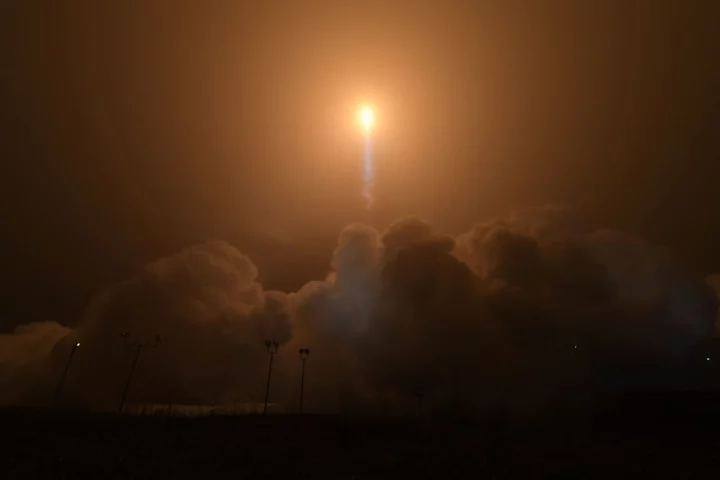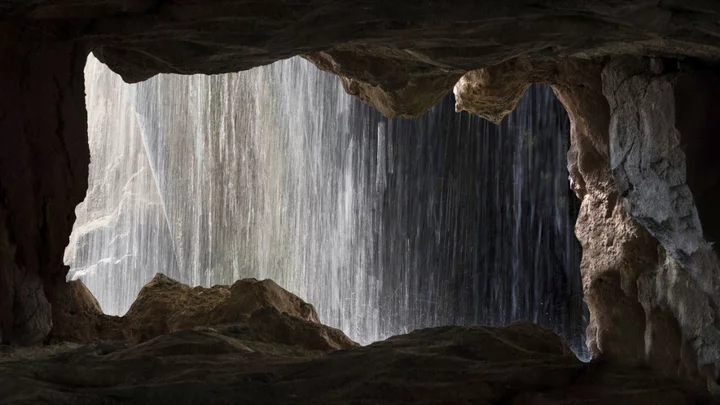
Jonathan Majors' accuser arrested in New York, won't be prosecuted
The woman who accused actor Jonathan Majors of assaulting her during a dispute in March was arrested Wednesday night on suspicion of assault and criminal mischief related to the same incident, according to a source with knowledge of the matter.
1970-01-01 08:00

LAIKA Unveils All New Online Shop Experience Featuring Exclusive Drops From Each of Its Five Award-Winning Films
HILLSBORO, Ore.--(BUSINESS WIRE)--Oct 26, 2023--
1970-01-01 08:00

Cemex’s Shares Rise on Higher Sales Even as Profits Fall 75%
Cemex SAB’s shares rose as sales beat estimates, even as the company reported a steep drop in profits.
1970-01-01 08:00

OPEC+ members send less oil to U.S., adding to tight supply outlook
By Stephanie Kelly and Alex Lawler NEW YORK U.S. waterborne imports of crude from OPEC+ members including Saudi
1970-01-01 08:00

Mobil 1™ and Steer Join Forces to Transform Automotive Service and Repair Experience
SPRING, Texas--(BUSINESS WIRE)--Oct 26, 2023--
1970-01-01 08:00

Scientists find surprise layer of molten rock underneath surface of Mars
Scientists have been forced to change their understanding of the inside of Mars after a major new breakthrough. Research looking at seismic waves that were generated when Mars was hit by a meteorite impact suggests that it has a previously unknown layer in its deep interior. Those waves were picked up by Nasa’s InSight lander, which was sent to Mars to better understand its seismic activity. The waves that the lander picked up can be used to get a picture of the anatomy of the planet, by watching how they travel around. The new data indicates the presence of a hitherto unknown layer of molten rock surrounding a liquid metallic core - the planet’s innermost component - that is smaller and denser than previously estimated, researchers said on Wednesday. Waves generated by quakes - including those caused by meteorite impacts - vary in speed and shape when journeying through different material inside a planet. Data from InSight’s seismometer instrument has enabled the planet’s internal structure to come into focus. The meteorite impact that occurred in a Martian highland region called Tempe Terra on Sept. 18, 2021, triggered a magnitude 4.2 quake and left a crater about 425 feet (130 meters) wide. It occurred on the opposite side of Mars from InSight’s location in a plains region called Elysium Planitia. “The importance of the far side impact was to produce seismic waves that traversed the deep interior of the planet, including the core. Previously, we had not observed any seismic waves that had transited the core. We had only seen reflections from the top of the core,” said planetary scientist Amir Khan of ETH Zurich in Switzerland, lead author of one of two scientific papers on the new findings published in the journal Nature. The behavior of the waves indicated that previous assessments of the Martian interior were missing something - the presence of a molten silicate layer about 90 miles (150 km) thick surrounding the core. This molten region sits at the bottom of the interior portion of the planet called the mantle. The researchers also recalculated the size of the core, finding that it has a diameter of about 2,080 miles (3,350 km), with a volume about 30% smaller than previously thought. The researchers said the mantle - a rocky layer sandwiched between the planet’s outermost crust and core - extends about 1,055 miles (1,700 km) below the surface. Unlike Mars, Earth has no molten layer around its core. One of the two studies published on Wednesday indicates this layer is fully molten, with the other indicating that most of it is fully molten, with the top portion partially molten. “The molten and partially molten layer is essentially composed of silicates (rock-forming minerals) that are enriched in iron and in radioactive heat-producing elements compared to the overlying solid mantle,” said Henri Samuel, a planetary scientist with the French national research organization CNRS working at Institut de Physique du Globe de Paris and lead author of the second study. The Martian core is made up mostly of iron and nickel, but also has some lighter elements such as sulfur, oxygen, carbon and hydrogen. The researchers concluded that these lighter elements make up about 9-15% of the core‘s composition by weight, lower than previously estimated. “This amount of light elements is not unlike that of the Earth’s core, which is estimated to be around 10%,” Khan said. Mars, the fourth planet from the sun, has a diameter of about 4,220 miles (6,791 km), compared to Earth’s diameter of about 7,926 miles (12,755 km). Earth is almost seven times larger in total volume. NASA retired InSight in 2022 after four years of operations. “We have learned a lot about Mars by studying the unique seismic record provided by the InSight mission,” Samuel said. “Planets are rich and complex systems because they are a place where many different types of processes coexist and act on various spatial and temporal scales, and Mars is no exception.” Additional reporting by Reuters Read More ‘Crystals brought back by Apollo astronauts indicate true age of the Moon’ Researchers reveal source of largest ever Mars quake Scientists investigate after huge shaking seen across Mars Scientists see huge explosion in space – and it could explain life Massive space explosion observed creating elements needed for life Tim Peake: Possibility of all-UK space mission a ‘very exciting development’
1970-01-01 08:00

Kendall Jenner shares why she's 'scared' to have children
Kendall Jenner, 27, has candidly opened up about her fears about having children. In a recent episode of The Kardashians, the model said that while she loves being an auntie, she's "scared" at the thought of having her own. She went on to make a heartbreaking confession to Scott Disick while talking about her dog Pyro. "I swear he [her dog, Pyro] has really bad separation anxiety," she told Disick, Kourtney Kardashian's ex. "I have anxiety and I think he has anxiety. Maybe I’m the problem, maybe he feels my anxiety? I could be the problem. I’ve been really bad lately. It’s one of the reasons why I’m actually scared to have children." Disick went on to acknowledge that while "it is scary," she "can’t not have kids because of it". Speaking about her mental health, Jenner responded: "The scariest part for me is am I just going to get worse throughout life? Because I feel like it’s worse than ever right now." Jenner then opened up about the first time she experienced anxiety at the age of eight when she told her mother Kris Jenner to take her to the hospital. "I thought there was something physically wrong with me," she said. "At that time people didn’t talk about anxiety the way they do now. I never knew that’s what that was until later in life." This isn't the first time the star has opened up about her anxiety struggles. In an interview with Vogue last year, she explained how she winds down with a cup of tea and reading a book or journaling. She added that 15 minutes of meditation helps "settle my anxiety so I can get a good night’s rest". How to join the indy100's free WhatsApp channel Sign up for our free Indy100 weekly newsletter Have your say in our news democracy. Click the upvote icon at the top of the page to help raise this article through the indy100 rankings.
1970-01-01 08:00

'Positions not matching yet' as EU leaders fight for slice of budget pie
By Gabriela Baczynska and Jan Strupczewski BRUSSELS From supporting Ukraine to boosting military might and managing migration, European
1970-01-01 08:00

Epsilon Advanced Materials (EAM) Announces Investment of $650M Manufacturing Facility in North Carolina to Strengthen EV Battery Industry in the United States
BOLIVIA, N.C.--(BUSINESS WIRE)--Oct 26, 2023--
1970-01-01 08:00

Scientist discovers oldest water on Earth and drinks it
A scientist who found the oldest water ever discovered on Earth decided the best course of action was, of course, to drink it. Professor Barbara Sherwood Lollar was leading a team of geologists studying a Canadian mine in 2016 when she made the remarkable discovery. The flowing water about three kilometres below the surface was between 1.5bn and 2.6bn years old, according to tests, making it the oldest water found on Earth. “When people think about this water they assume it must be some tiny amount of water trapped within the rock,” said Prof Sherwood Lollar. “But in fact it’s very much bubbling right up out at you. These things are flowing at rates of litres per minute – the volume of the water is much larger than anyone anticipated.” Upon tasting the ancient water, she found that it was “very salty and bitter” and “much saltier than seawater”. That was an encouraging sign, because saltier water tends to be older. In this case, where the water has been ageing for billions of years, it is hardly surprising. “If you’re a geologist who works with rocks, you’ve probably licked a lot of rocks,” said Sherwood Lollar. Her team also found that life had once been present in the water, by looking at the sulphate – the composition of salts – in it. “We were able to indicate that the signal we are seeing in the fluids has to have been produced by microbiology – and most importantly has to have been produced over a very long time scale. “The microbes that produced this signature couldn’t have done it overnight. “This has to be an indication that organisms have been present in these fluids on a geological timescale.” Fortunately, the scientist had no terrifying sci-fi movie-esq reaction to drinking the ancient water, and lived to tell the tale. The paper was published in Nature in 2016. How to join the indy100's free WhatsApp channel Sign up to our free Indy100 weekly newsletter Have your say in our news democracy. Click the upvote icon at the top of the page to help raise this article through the indy100 rankings.
1970-01-01 08:00

The average long-term US mortgage rate rises for 7th straight week, 30-year loan reaches 7.79%
The average rate on the benchmark 30-year home loan rose for the seventh straight week, making a significant hurdle for prospective homebuyers
1970-01-01 08:00

Warren Buffett's company joins oil-buying frenzy this week by resuming its Occidental Petroleum buys
Investor Warren Buffett joined the recent oil-buying spree in the market this week by resuming Berkshire Hathaway's purchases of Occidental Petroleum stock for the first time in four months
1970-01-01 08:00
